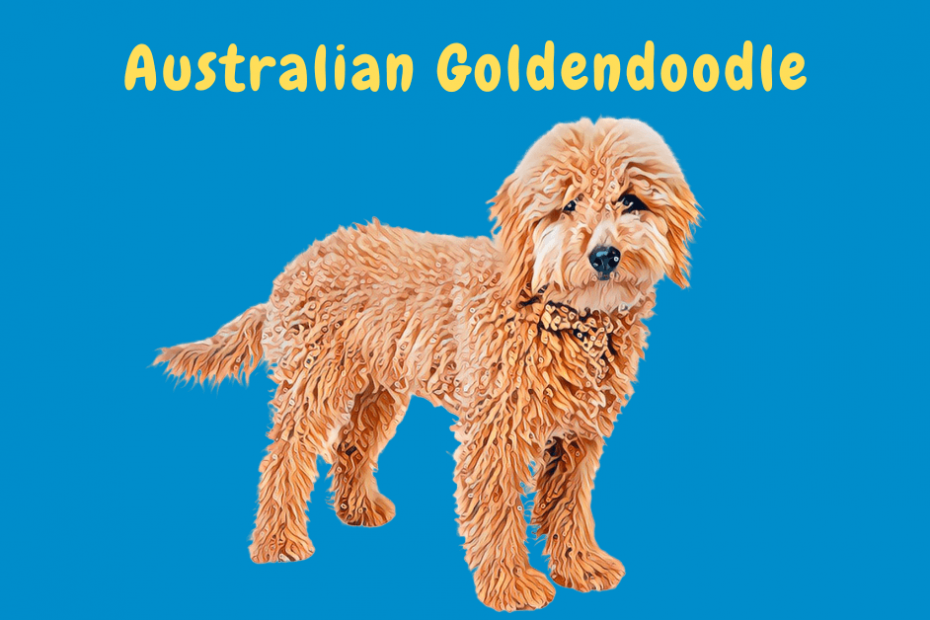A Goldendoodle from Australia would be referred to as an Australian Goldendoodle. But there’s actually a separate Doodle breed that is referred to as the Australian Goldendoodle.
It is a mix between a Cocker Spaniel, Golden Retriever, Labrador Retriever, and a Poodle.
Now you might be thinking, how is that possible? Well, check out this complete guide to the Australian Goldendoodle, and I bet you will find the answer to that question and much more!
What Is an Australian Goldendoodle?
An Australian Goldendoodle is a cross between an English Goldendoodle and an Australian Labradoodle.

The English Goldendoodle is a mix between an English Golden Retriever and a Poodle. The Australian Labradoodle is a mix between the Cocker Spaniel, Poodle, and Labrador Retriever.
Now, you’re probably wondering how a dog can be a mix of three different breeds. I’ll take a deeper dive into this in a following section.
As you can see in the chart below, the Australian Goldendoodle is a mix of four different dog breeds: Cocker Spaniel, Poodle, Labrador Retriever, and Golden Retriever.
Ultimately, the Australian Goldendoodle is a designer dog. Designer dogs are a result of breeders choosing purebred parents with desirable traits. The Australian Goldendoodle is technically a Doodle dog breed since it is a Poodle mix.
They are not Aussiedoodles
People often confuse Australian Goldendoodles with Aussiedoodles because they think it’s an abbreviation of the same name. However, Aussiedoodles are a mix between an Australian Shepherd and a Poodle.
To better understand the Australian Goldendoodle, let’s take a closer look at the parent breeds.
The Australian Labradoodle
The first parent breed I’ll focus on is the Australian Labradoodle. They are not to be confused with a standard Labradoodle. There are quite a few differences worth pointing out.
Standard Labradoodle vs Australian Labradoodle
The standard Labradoodle is a simple cross between a Labrador Retriever and a Poodle.
Although Poodles have been mixed with other breeds for decades, if not centuries, the Labradoodle is credited as the first official Doodle breed.
In 1989, Wally Conron, a dog breeder who worked for the Victoria Royal Guide Dog Association of Australia, created the first Labradoodle to provide a hypoallergenic service dog.
This cross-breed came from a letter he received from a man in Hawaii who needed a guide dog but was sensitive to dog allergens.
The success of this Labradoodle guide dog caught the interest of many. Standard Labradoodles have grown in popularity ever since.
The Australian Labradoodle is a direct descendant of the standard Labradoodle. About a decade after Conron’s discovery, breeders in Australia began breeding Labradoodles with other dog breeds.
The intent behind this selective breeding was to create more consistent litters in regards to coat type, traits, size, and temperament [1]alaa-labradoodles.com.

Due to the advocacy of breed clubs like the Australian Labradoodle Association of America, Australian Labradoodles now have entirely predictable traits, with the breed standard established in 1997.
The Australian Labradoodle is still considered a mixed-breed dog, but breeders hope that they can one day be distinguished as its own breed.
The most significant difference between the Australian Labradoodle and the standard Labradoodle is that the Australian Goldendoodle is a mix of several different dog breeds. These include the Labrador Retriever, Poodle, and Cocker Spaniel (American or English).
How popular are Australian Labradoodles?
Australian Labradoodles are currently much more popular than Australian Goldendoodles. The mix has yet to receive much attention, but the data shows it is trending upward.
The graph below shows the relative search volume of Australian Labradoodles and Australian Goldendoodles worldwide. It is clear that Australian Labradoodles are more popular than Australian Goldendoodles.
However, this trend can change in no time!

A Closer Look at the Parent Breeds
The Australian Goldendoodle is a mix of two hybrid breeds: the Goldendoodle and the Australian Labradoodle. These two hybrid breeds are a result of four different parent breeds.
The Australian Labradoodle comes from selective breeding between Poodles, Cocker Spaniels, and Labrador Retrievers. The English Goldendoodle comes from a mix between the English Golden Retriever and Poodle.
We will examine each parent breed’s key characteristics and why breeders choose to use them.
Poodle

Poodles are a breed of water dog that originated in Germany. The name “Poodle” comes from “pudel,” a German word that means “to splash in” in English.
They were bred to be water-fowl hunters and retrievers. They are intelligent dogs that have high energy levels and are athletic. This is why they eventually became famous as circus dogs in 19th-century France.
There are three varieties of Poodle, which differ by size: Toy, Miniature, and Standard. The standard Poodle is the largest, while the Toy Poodle is the smallest.
Breeders consider the Poodle’s coat to be hypoallergenic. This is the main reason Doodle breeders mix them with other purebred dogs.
Poodles do not shed as often as other breeds, and the curly nature of their coat traps dander. However, they require quite a bit of grooming to prevent the matting of their fur.
They come in various colors: black, white, gray, fawn, brown, blue, red parti, and a few others.
Cocker Spaniel
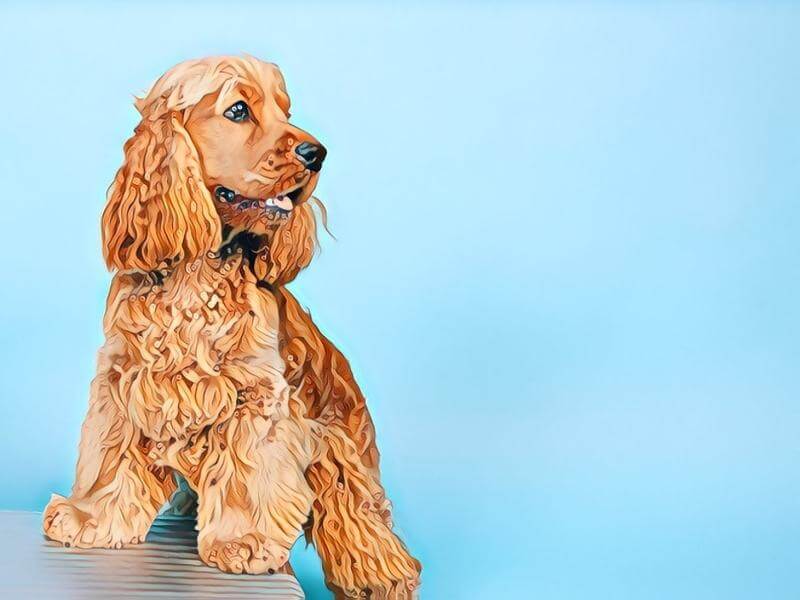
Cocker Spaniels were originally bred as hunting or gun dogs. Their temperament was the main reason breeders chose them for Australian Labradoodle breeding.
Cocker Spaniels are social and people orientated. In addition, they are not as energetic as the other dog breeds. This makes them calmer and more suitable for families.
Cocker Spaniels come in a variety of colors, including mixtures of colors as well. There are two main Cocker Spaniels – English Cocker Spaniel and American Cocker Spaniel.
English Cocker Spaniel vs. American Cocker Spaniel
English Cocker Spaniels were originally famous for hunting Eurasian Woodcock. However, when the breed was brought over to America, it was bred differently to be able to hunt American woodcock.
Thus, the breeds differ, given their different physical characteristics and instincts. American Cocker Spaniels are smaller in size. They have a shorter muzzle and back with a dome-shaped head.
The English Spaniel is taller and has a narrower head and chest. In their native countries, they are simply called Cocker Spaniels. Similarities between the two include the signature long ears and thick wavy fur.
Labrador Retriever
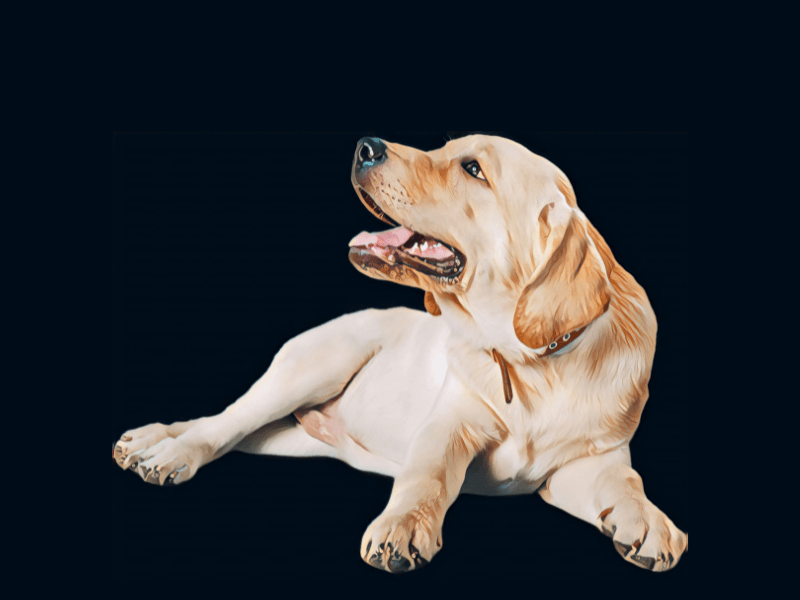
The Labrador Retriever is a famous British gun dog breed, one of the most popular choices for families in the western world.
In addition to being playful, loyal, and obedient, Labrador Retrievers are the dog of choice for service or guide dogs. They come in three primary colors – black, yellow/golden, and chocolate. Their coats are short and water-proof but tend to shed a lot.
Their addition as parent breeds for the Australian Labradoodle is because they were the original service dogs that breeders wanted to adapt for people with allergies.
The English Goldendoodle
The second parent breed of the Australian Goldendoodle is the English Goldendoodle.
This breed results from a cross between an English Golden Retriever and Poodle. They have a few slight differences from a standard Goldendoodle, most of which are based on coloring and body shape.
It was first bred in the ’90s and has become a popular dog breed. The size of an English Goldendoodle depends on the Poodle parent and can vary widely. Due to its size, the Mini English Goldendoodle sees more demand across households.
The English Goldendoodle usually retains the social characteristics of a Golden Retriever and the intelligence and coat of a Poodle.
Due to their light color, they are sometimes called English Cream Golden Retrievers. As a result, English Goldendoodles can also be referred to as English Cream Goldendoodles (or English Crème Goldendoodles).
We have already gone through the characteristics of the Poodle, so let’s take a quick look at the English Golden Retriever.
English Golden Retriever
The English Golden Retriever differs from the American Golden Retriever, mostly in coloring. English Golden Retrievers have a very light cream-colored coat that almost seems white.
American Golden Retrievers are never that light in color. Furthermore, English Golden Retrievers tend to be slightly larger than their American counterparts.
Both these dogs are brilliant and highly energetic. They require lots of activity and attention. They make great family dogs and are easy to train.
English Golden Retrievers are more laidback than American Retrievers and, therefore, don’t get too agitated when left alone.
Where did the English Golden Retriever come from?
Since the English Golden Retriever is not a separate breed, it shares the same history as the standard Golden Retriever.
Lord Tweedmouth is credited as the founder of the Golden Retriever breed. In the mid-1800s, he bred a Yellow Retriever with a Tweed Water Spaniel. At the time, hunting was becoming a very popular sport in both Scotland and England.
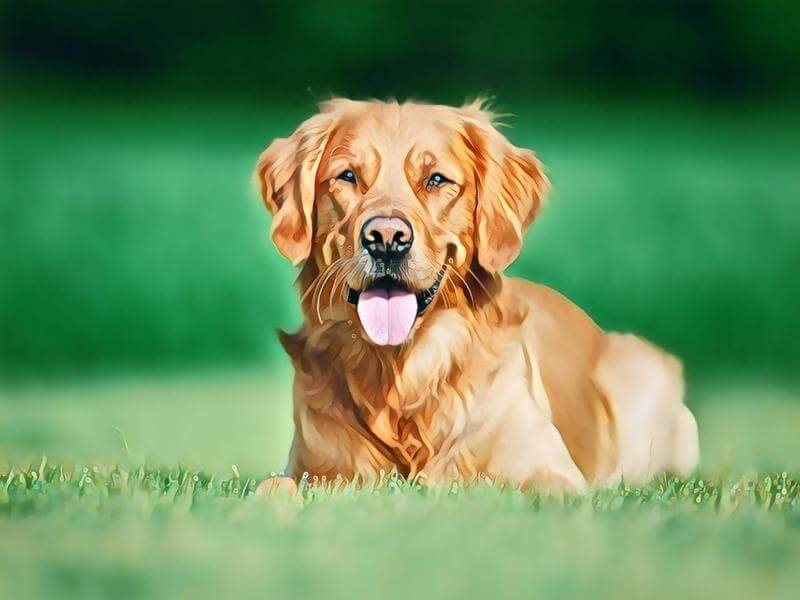
This particular mix was bred with the intent to aid hunters in the retrieval of waterfowl and upland hunting. Upland hunting refers to the hunting of upland game, which are non-waterfowl birds such as pheasants, quail, grouse, etc. [2]www.orvis.com/what-is-upland-hunting.html
Golden Retrievers, American or English, are still used in hunting, but they have become one of the most popular household pets in the United States (and the world). Their sweet-temperament intelligence makes them a great choice to be used as a service dog, guide dog, or therapy dog.
Australian Goldendoodle Size
The size and weight of an Australian Goldendoodle can vary greatly. This is because it depends on the sizes of all the breeds that make up an Australian Goldendoodle.

Goldendoodles generally come in three different sizes – Standard, Miniature, and Toy. Some breeders also market “medium” Goldendoodles, which would be slightly smaller than the standard size.
You should be able to get specific weight and size from your breeder. If you want to know how big your puppy will get, ask for specifics on the size of the parents.
Weight
The following table estimates the weight of an adult Australian Goldendoodle based on type.
| Australian Goldendoodle Size | Min Weight | Max Weight |
|---|---|---|
| Toy | 6 lbs | 20 lbs |
| Mini | 20 lbs | 35 lbs |
| Medium | 35 lbs | 50 lbs |
| Standard | 40 lbs | 70+ lbs |
Height
The height of an Australian Goldendoodle mainly depends on the parents’ height. The generation (ex: F1 Goldendoodles vs. F2 Goldendoodles) and gender will affect the final adult height.
The table below offers a general height estimate based on the Australian Goldendoodle type.
| Australian Goldendoodle Size | Min Height | Max Height |
|---|---|---|
| Toy | – | up to 12 in |
| Mini | 12 in | 16 in |
| Medium | 16 in | 21 in |
| Standard | 21+ | – |
Appearance
Australian Goldendoodles are exceptionally adorable dogs.
They have floppy ears and facial hair resembling a mustache. This mustache-like fur is known as furnishings and gives them their characteristic teddy bear appearance.
Coat Type
The Australian Goldendoodle has three different coat types. Their coats can be straight, wavy, or curly. However, the dog breed is still considered long-haired, no matter the coat type.
Since Australian Goldendoodles shed less than other breeds, they are considered hypoallergenic.
Grooming
Their coats do require quite a bit of maintenance. Regular brushing or grooming prevents their curly or wavy coats from getting matted or tangled.
Furthermore, it is worthwhile to begin the grooming processes of an Australian Goldendoodle from a young age to become accustomed to it as they grow older.
Most puppies from this breed have their coat trimmed every six to eight weeks.
Coat Colors
Australian Goldendoodles can come in many different coat colors. These coat colors can be solid or mixed with unique markings (tuxedo, tri-colored, mask, etc.).
Here is a list of all the possible colors an Australian Goldendoodle can be:
- Apricot
- Black
- Blue
- Brown
- Café au Lait
- Caramel
- Caramel Ice
- Caramel Red
- Chocolate
- Cream (or crème)
- Gold
- Gray
- Red
- Sable
- Silver
- Tan
- White
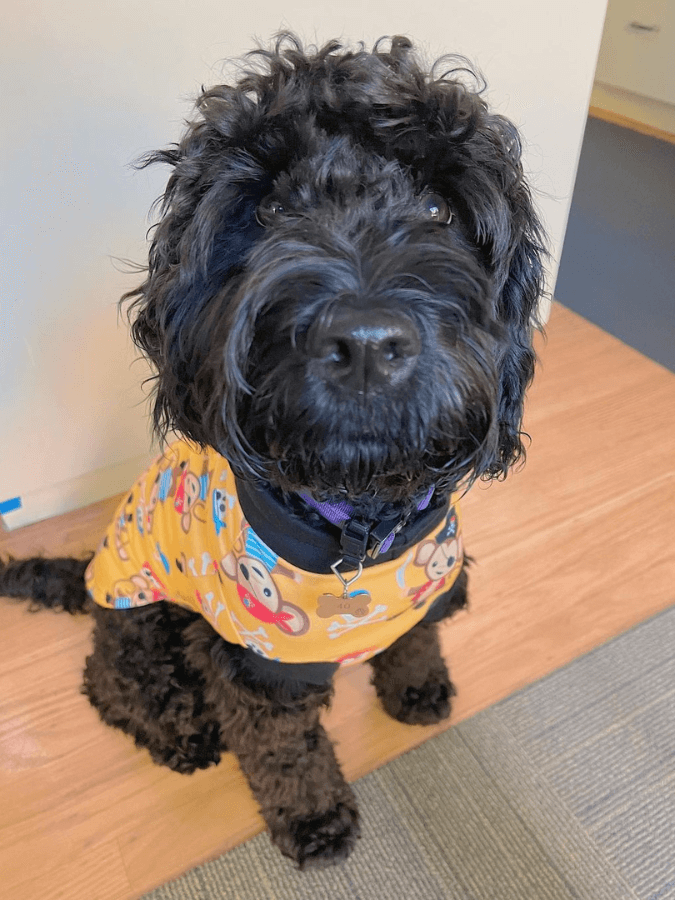
They can also have mixed coats known as parti. Also, it is possible to have unique coat patterns such as merle, phantom, or tuxedo. There is red merle, blue merle, and sable merle (or chocolate merle).
Ultimately, the coat color of a litter will be influenced mainly by the parents’ coloring.
Temperament
Australian Goldendoodles have an excellent temperament, thanks to their parent breeds. Despite their high energy level, they are friendly, intelligent, and relatively gentle dogs.
The Australian Goldendoodle makes for a perfect family dog because they love spending time with their families and playing.
They adapt well to children, although larger Australian Goldendoodles may knock over small children unintentionally.
Their intelligence makes them very easy to train, which is also why they work well as service dogs. Furthermore, due to their pleasant temperaments, Australian Goldendoodles are excellent therapy dogs often found in hospitals and nursing homes.

Health Issues
The Australian Goldendoodle is a healthy dog breed, given its genetic diversity. However, they are prone to a few health conditions. These conditions include the following:
Ear Infections: Due to their floppy ears, Australian Goldendoodles are prone to ear infections if their ears are not cleaned regularly. Thus, ear cleaning should be a part of their regular grooming routine.
Hip Dysplasia: This condition is shared amongst all dog breeds, but Australian Goldendoodles may inherit this condition from their Labrador and Retriever genes. Hip Dysplasia is when the hip moves out from its joint, causing a dog to have difficulty walking and moving about [3]www.ncbi.nlm.nih.gov/pmc/articles/PMC6070021/.
Addison’s Disease: Common in Poodles, Addison’s disease is when the adrenal glands do not produce enough corticosteroids [4]www.ncbi.nlm.nih.gov/pmc/articles/PMC6055912. Fortunately, the condition is treatable, and dogs can live normal lives if caught early.
My Bernedoodle was tested for Addison’s disease at a relatively early point in her life. The testing was not too intensive and provided peace of mind once it was completed.
Von Willebrand’s Disease: This is another disease that an Australian Goldendoodle may inherit from its Poodle parent. Von Willebrand’s disease is a blood disease that prevents blood from clotting. This may cause a dog to bleed excessively when injured and delay its healing time.
Subaortic Stenosis: Some Australian Goldendoodles may inherit this congenital heart defect from their Golden Retriever genes. Dogs that have Subaortic Stenosis have a narrow aortic valve. Thus, blood flow to the heart is compromised, and heart failure can occur.
Progressive Retinal Atrophy: Despite being generally healthy dogs, Australian Goldendoodles are at a higher risk of progressive retinal atrophy (PRA). PRA is a disease that involves a gradual deterioration of vision.
Australian Goldendoodles are susceptible because it is common in three of their parent breeds (Cocker Spaniel, Poodle, and Labrador Retriever) [5]vetspecialists.co.uk/fact-sheets-post/progressive-retinal-atrophy-pra-fact-sheet.
Other possible conditions to keep an eye out for are patellar luxation and elbow dysplasia,
An experienced breeder should be able to provide health certificates and genetic testing for most of these common health problems. This will help you better care for them as you know what genes they carry.
Life Expectancy
The life expectancy of the Australian Goldendoodle tends to be quite long. Most dogs from this breed live between 10 to 15 years. In addition, smaller Australian Goldendoodles tend to live longer than the larger varieties.
Energy Level
The Australian Goldendoodles are more laidback than their parental breeds. However, they are pretty active dogs. They require at least two hours of activity per day.
Therefore, they are not the dog breed for your lifestyle if you cannot provide them with activities. That being said, smaller Australian Goldendoodles will not be able to run for long periods and do better with slow walks.
It is also important to note that puppies and adults require different activities. Australian Goldendoodle puppies are pretty playful and energetic.
Thus, they fare better with shorter walks and more playtime. Adult dogs enjoy long walks or just being outdoors in general.
Furthermore, due to the breed’s trainability, you can easily use training as part of their exercise routine and teach them to play various sports.
Where Can You Find a Breeder?
Finding Australian Goldendoodle breeders can be an intensive task. You have to ensure that the breeder is reputable and avoid puppy mills.
Not only will this ensure your pup’s health, but it will also prevent you from supporting these horrendous mills.
The internet is usually everyone’s first stop to check where they can find a breeder. It is crucial that you know how to spot any suspicious breeders.
Firstly, reputable breeders will not shy away from any questions you have. They have nothing to hide and will answer all questions easily. Secondly, most reputable breeders will also ask you questions.
They will want to ensure that you know about the breed and how to care for them. Lastly, they will allow you to meet the parents and answer their health-related questions.
Furthermore, reputable breeders will not produce many litters throughout the year. Thus, you may find yourself on a waiting list for your puppy.
You can also visit your local vet and ask if they know of reputable breeders nearby. This will save you the cost of transporting your puppy from a distant location.
Therefore, looking for a good breeder with a solid breeding program is worthwhile.
Chances are, you will not receive your puppy immediately. However, this gives you time to prepare for the new addition to your family.
How Much Do Australian Goldendoodles Cost?
Australian Goldendoodle puppies typically range in price between $2600 and $4000.
Australian Goldendoodles are not cheap dogs. The breeding process is quite intensive and takes a lot of work.
In addition, some breeders also conduct tests to ensure the puppies’ health and provide health certification for the parent dogs. Thus, the price of these pups is relatively high.
The price of puppies ranges due to the differences in size, lineage, colors, and breeders. You will most likely have to pay a deposit for a puppy because it is in high demand and often advertised before birth.
Final Thoughts
It turns out the Australian Goldendoodle is not simply a Goldendoodle from Australia. This unique Doodle breed might be the ultimate Doodle mix, considering it’s a mix of four different dog breeds.
Now it’s time to start searching for Australian Goldendoodle puppies near you…
FAQs
Are There Mini Australian Goldendoodles?
Yes. A Mini Australian Goldendoodle results from a cross between a Mini English Goldendoodle and an Australian Labradoodle or vice versa. Since Poodles come in miniature and toy sizes, they can be used for breeding Mini English Goldendoodles and Mini Labradoodles, which are then used for breeding Mini Australian Goldendoodles.
Are Australian Goldendoodle good with young children?
Australian Goldendoodles are great with young children. They inherit a sweet and gentle temperament from their parent breeds. They are a perfect choice for a companion to small kids. Their size and energy can overwhelm young kids, so keep an eye out if they get too excited!
Are Australian Goldendoodles good service dogs?
Absolutely! The parent breeds contribute qualities that help make the Australian Goldendoodle an excellent choice as a service or guide dog. As a mix with high intelligence, you must introduce proper training at an early age, and the Australian Goldendoodle would be perfect for service or therapy roles.
Do Australian Goldendoodles like to swim?
Yes, Australian Goldendoodles love to swim. They are naturals in the water since their genetics are inherited from three water-loving dog breeds: the Poodle, Golden Retriever, and Labrador Retriever.
Related Posts
- Searching for a smaller-sized Goldendoodle? The Mini English Goldendoodle is worth checking out.
- Explore the original (or standard) Golden Retriever-Poodle mix.


